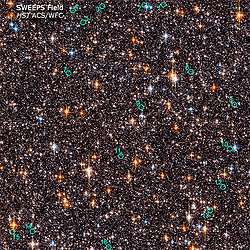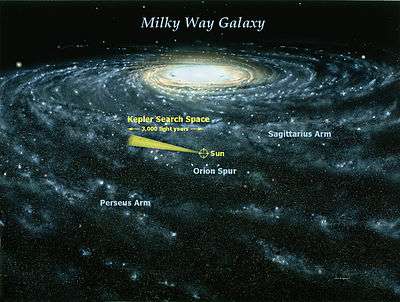MOST (satellite)
| Names | MOST |
|---|---|
| Mission type | Astronomy |
| Operator | CSA |
| COSPAR ID | 2003-031D |
| SATCAT № | 27843 |
| Website | MOST home page |
| Spacecraft properties | |
| Launch mass | 53 kg (117 lb) |
| Dimensions | 66 cm × 20 cm (26.0 in × 7.9 in) |
| Power | 35 W |
| Start of mission | |
| Launch date | 14:15, June 30, 2003 |
| Rocket | Rockot/Breeze-KM |
| Launch site | Plesetsk 133/3 |
| Contractor | Eurockot |
| Orbital parameters | |
| Reference system | Geocentric |
| Regime | Polar |
| Semi-major axis | 7,203 km (4,476 mi) |
| Eccentricity | 0.0010821 |
| Perigee | 824.7 km (512.4 mi) |
| Apogee | 840.3 km (522.1 mi) |
| Inclination | 98.7157 degrees |
| Period | 101.4 minutes |
| RAAN | 126.1054 degrees |
| Argument of perigee | 129.3968 degrees |
| Mean anomaly | 230.8168 degrees |
| Mean motion | 14.20521415 rev/day |
| Epoch | 27 April 2016, 11:16:58 UTC[1] |
| Revolution number | 66487 |
| Main telescope | |
| Type | Maksutov catadioptric |
| Diameter | 15 cm (5.9 in) |
| Focal length | 88.2 cm (34.7 in) |
| Wavelengths | 350-750 nm (Visible light) |
The Microvariability and Oscillations of Stars telescope, better known simply as MOST, is Canada's first space telescope. Up until nearly 10 years after its launch it was also the smallest space telescope in orbit (for which its creators nicknamed it the “Humble Space Telescope”, in reference to one of the largest, the Hubble).[2] MOST is the first spacecraft dedicated to the study of asteroseismology, subsequently followed by the now-completed COROT and Kepler missions. It was also the first Canadian science satellite launched since ISIS II, 32 years previously.
Description
As its name suggests, its primary mission is to monitor variations in star light, which it does by observing a single target for a long period of time (up to 60 days). Typically, larger space telescopes cannot afford to remain focused on a single target for so long due to the demand for their resources.
At 53 kg (117 pounds) 65 cm (26 in) wide and tall and 30 cm (12 in) deep, it is the size and weight of a small chest or an extra-large suitcase filled with electronics. This places it in the microsatellite category.
MOST was developed as a joint effort of the Canadian Space Agency, Dynacon Enterprises Limited (now Microsatellite Systems Canada Inc), the Space Flight Laboratory (SFL) at the University of Toronto Institute for Aerospace Studies, and the University of British Columbia. Led by Principal Investigator Jaymie Matthews, the MOST science team's plan is to use observations from MOST to use asteroseismology to help date the age of the universe, and to search for visible-light signatures from extrasolar planets.
MOST features an instrument[3] comprising a visible-light dual-CCD camera, fed by a 15-cm aperture Maksutov telescope. One CCD gathers science images, while the other provides images used by star-tracking software that, along with a set of four reaction wheels (computer-controlled motorized flywheels that are similar to gyroscopes) maintain pointing with an error of less than 1 arc-second, better pointing by far than any other microsatellite to date.
The design of the rest of MOST was inspired by and based on microsatellite bus designs pioneered by AMSAT, and first brought to commercial viability by the microsatellite company SSTL (based at the University of Surrey in the UK); during the early stages of MOST development, the core group of AMSAT microsatellite satellite designers advised and mentored the MOST satellite design team, via a know-how transfer arrangement with UTIAS. This approach to satellite design is notable for making use of commercial-grade electronics, along with a "small team," "early prototyping" engineering development approach rather different from that used in most other space-engineering programs, to achieve relatively very low costs: MOST's life-cycle cost (design, build, launch and operate) is less than $10 million in Canadian funds (about 7 million Euros or 6 million USD, at exchange rates at time of launch).
Development of the satellite was managed by the Canadian Space Agency's Space Science Branch, and was funded under its Small Payloads Program; its operations are currently (as of 2012) managed by the CSA's Space Exploration Branch. It is operated by SFL (where the primary MOST ground station is located) jointly with Microsat Systems Canada Inc. (since the sale of Dynacon's space division to MSCI in 2008). As of ten years after launch, despite failures of two of its components (one of the four reaction wheels and one of the two CCD driver boards), the satellite is still operating well, as a result of both on-going on-board software upgrades as well as built-in hardware redundancy, allowing improvements to performance and to reconfigure around failed hardware units.
In 2008 the MOST Satellite Project Team won the Canadian Aeronautics and Space Institute's Alouette Award,[4][5] which recognizes outstanding contributions to advancement in Canadian space technology, applications, science or engineering.
Termination of Operations Funding by CSA
On 30 April 2014, the Canadian Space Agency announced that funding to continue operating MOST would be withdrawn as of 9 September 2014,[6] apparently as a result of funding cuts to the Canadian Space Agency's budget by the Harper government,[7] despite the fact that the satellite continues to be fully operational and capable of making on-going science observations. P.I. Jaymie Matthews responded by saying that "he will consider all options to keep the satellite in orbit, and that includes a direct appeal to the public."
Current Operations
In October 2014, the MOST Satellite was acquired by Microsatellite Systems Canada Inc. (MSCI), who has operated the satellite since launch in 2003. MSCI engineers have monitored the satellite's health over the years and have performed numerous upgrades to the software. MSCI has commenced commercial operation of the satellite and offers a variety of potential uses including continuing the original MOST mission in partnership with Dr. Matthews, but also other planetary studies, attitude control system algorithm R&D, and Earth observation. MSCI is also the prime contractor for the NEOSSat spacecraft.
Discoveries
The MOST team has reported a number of discoveries. In 2004 they reported that the star Procyon does not oscillate to the extent that had been expected,[8] although this has been disputed. In 2006 observations revealed a previously unknown class of variable stars, the "slowly pulsating B supergiants" (SPBsg).[9] In 2011, MOST detected transits by exoplanet 55 Cancri e of its primary star, based on two weeks of nearly continuous photometric monitoring, confirming an earlier detection of this planet, and allowing investigations into the planet's composition. Further reports of discoveries are listed on the MOST science page at the University of British Columbia.
MOST Target Campaigns
- Procyon
- HD 209458 b
- HD 163899 (guide star)
- 55 Cancri e
- HIP 116454 b[10]
See also
References
- ↑ "XTE Satellite details 1995-074A NORAD 23757". N2YO. 27 April 2016. Retrieved 27 April 2016.
- ↑ MOST home page news item of June 30, 2008, retrieved 2008-09-07.
- ↑ http://www.astro.ubc.ca/MOST/papers/walker.pdf Walker et al., "The MOST Asteroseismology Mission: Ultraprecise Photometry from Space," Publications of the Astronomical Society of the Pacific , Vol.115, No.811 (September 2003), pp.1023-1035, DOI: 10.1086/377358.
- ↑ The Alouette Award, The recipients Canadian Aeronautics and Space Institute website, retrieved 2011-10-05.
- ↑ MOST Team Wins Alouette Award 2008 UTIAS SFL website.
- ↑ CSA announces termination of MOST operations funding
- ↑ CBC story, "MOST space telescope eyes crowdfunding to stay in orbit"
- ↑ CSA - Small Satellite Makes Big Discovery
- ↑ [astro-ph/0606712] Most Detects G- and P-Modes in the B Supergiant HD 163899 (B2Ib/II)
- ↑ Shore, Randy (December 18, 2014). "UBC astronomers help spot new 'waterworld' planet in our (galactic) neighbourhoody". The Province. Retrieved December 19, 2014.
External links
- MOST: Canada's First Space Telescope
- Microsat Systems Canada Inc. - MOST
- UTIAS Space Flight Laboratory
- Canadian Space Agency - MOST

